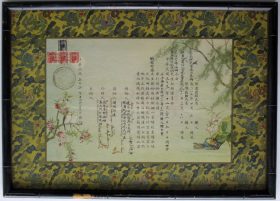– How Jewish Memory Objects Preserve Chinese History

Chinese marriage certificate for Irma Bielschowsky (1902–2000) and Albert Elias Less (1887–1952), 1944; Jewish Museum Berlin, gift of Gert and Brigitte Stroetzel
I recently shared my view on several objects from Shanghai in the museum’s collection on this blog. Now, I want to draw your attention to a few marriage certificates that caught my eye not just because of their elegant design and well-preserved condition after more than 70 years, but also because I was amazed how Chinese cultural elements had entered and influenced the life of Jews who fled the Nazi rule, even though the Jews largely maintained their own cultural and educational activities in Shanghai with newspapers, Jewish schools, concerts, sport activities, theaters (e.g. Delila, Nathan der Weise, etc.), and parties (e.g. a not so sober celebration of Purim). → continue reading
Ghetto Life and Beautiful Shoes

Wei Zhang looking at shoes “made in China”, which are part of the Jewish Museum Berlin’s collection; permanent loan by Marion Schubert, née Salomon; Jewish Museum Berlin, photo: Christoph Kreutzmüller
As a student studying the Holocaust at the University of Haifa, I was honored to do a short-term internship at the Jewish Museum Berlin with the team working on the new permanent exhibition. Before it began, I came across a small passage in the book Jewish Responses to Persecution: 1938–1940 (ed. by Jürgen Matthäus, Alexandra Garbarini, Plymouth: AltaMira Press, 2010) written in late 1938, directly after the November pogroms, that illustrated the desperation of German Jews (especially those in Berlin):
“There is one Jewish café open in Berlin. Anyone who wants to see what likely suicides look like should enter this café. The conversation of people sitting there revolves round two topics: how to obtain a passage to Shanghai or how to commit suicide.”
A question came to my mind: Could I find something related to Shanghai, the city where about 20,000 Ashkenazi Jews found refuge, here? As I started my research in the museum’s collection, I was excited to find an abundance of such information. Now I would like to share these stories with you. → continue reading

